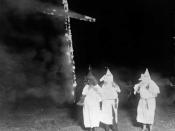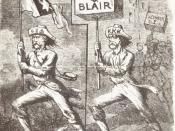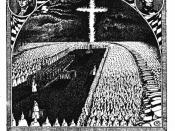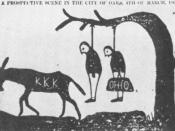The USA was a racist society to a large extent between 1919 and 1941, however it peaked in the years during and immediately after the Depression, as blacks and immigrants faced antagonism due to their holding of jobs, however menial they were. Whilst some gains were made in the black rights movement, there were still underlying racist tones throughout the country.
Racism, especially towards African Americans, was ingrained in the average white American's mind, and existed throughout the 1920s. The strong racism faced by blacks in the south resulted in the Great Migrations to the North. However, the treatment of blacks in the North didn't substantially differ from that in the South. "I discovered that Plainfield [New Jersey] was as segregated as the Southâ¦I didn't see any difference, because the theatres were segregated, the hospitals were segregated, the churches of course." (Rebecca Taylor.) Black families with enough money to afford better housing than the crowded, dirty, urban slums in the cities, struggled to make a purchase because of racial prejudice.
The Federal Housing Authority, an organisation to protect homeowners and make mortgages easier to obtain, used a system that discriminated against black loan applicants seeking mortgages for house in areas where there was a mix of different peoples. "If a neighbourhood is to retain its stability, it is necessary that properties continue to be occupied by the same social and racial classes." (Underwriting Manual, 1939)"The Great Depression was, of course, an economic disaster for most Americans, but black people suffered a disproportionate share of the burden."(McElvaine). During the Great Depression, and extending to the start of World War II, African Americans found themselves competing with white Americans who were now competing with them for menial and unskilled jobs. Whites demanded that blacks be fired in jobs such as domestic servants, garbage collectors, elevator operators, waiter, and subsequently, black workers were the first to be fired when the Depression hit. By 1932, black unemployment reached roughly 50% nationwide. Slogans such as "No jobs for Niggers until every white man has a job" were adopted by racist white groups throughout the country. "there will be no Negroes pushing wheelbarrows and boys driving trucks getting 40 cents an hour when the good white men and women, working on the fields alongside these roads can hardly earn 40 cents a day." The words of a Georgian official. As more white men became unemployed , there was increasing antagonism towards afro-Americans who held jobs, resulting in the number of lynchings increasing from 8 in 1932 to 28 in 1933. Blacks who kept their jobs suffered great hardship, with a 1935 study showing that black workers experienced an average wage drop of nearly 50% since the onset of the DepressionThe increased racism in US society during this time resulted in groups such as the Ku-Klux-Klan rising in prominence. "Ku Klux practices were being resume din the certainty that dead men did not only tell no tales but created vacancies"(McElvaine) However, the KKK had been practicing racist behavior throughout the 1920s as well. The number of lynchings by the KKK from 1918 to 1927 totalled 416 African Americans, mostly in the South. In Florida, when two black men attempted to vote in November 1920 in Ocoee, Orange County, the Klan attacked the black community. In the ensuing violence, six black residents and two whites were killed, and twenty five black homes were destroyed. Racial conflict existed between the KKK and other races apart from blacks during this period. In reaction to the social changes occurring in America in this period, the Klan adopted anti-Jewish, anti-Catholic, anti-Communist and anti-immigrant slants. The social unrest of the postwar period included labour strikes over low wages and working conditions in many industrial cities, often led by immigrants, who also organised unions. Klan members worried about labour organisers and socialist backgrounds of some of the immigrants, which added to the tensions. They also resented upwardly mobile ethnic Catholics or any others they identified as foreigners.
Mexicans were also discriminated against during this period. During the Depression about 40000 Mexicans had entered the USA legally, with another 1-2 million illegally. Like African Americans, the majority of Mexicans were illiterate and unskilled, and as a result received similar racist treatment from whites. In the years during the Depression, 400000 Mexican Americans were illegally deported from the South West, in order that whites could get more jobs or government relief.
Racist attitudes continued through the 1930s and up until the Second World War. Americans saw Asians as inferior, and when Japan rise to prominence in the Pacific, policies were enacted in order to keep the "yellows" out. "Yellow fever" swept the nation throughout the 1930s, and states such as California banned Japanese immigrants completely.
BibliographY:Dixon, T. Key Features of Modern History, Oxford University Press, 2005.





